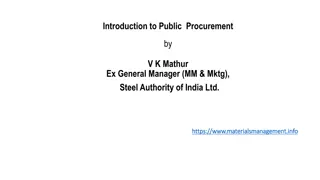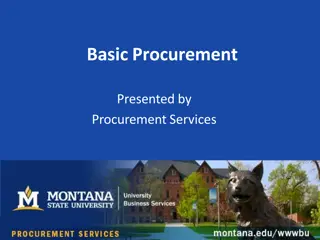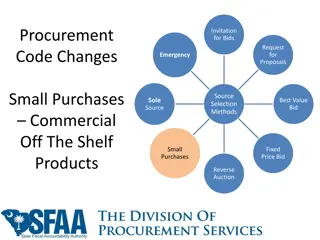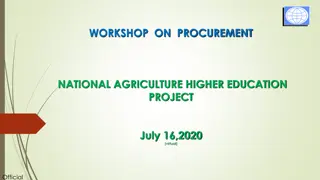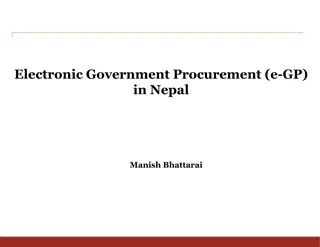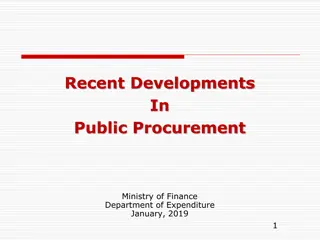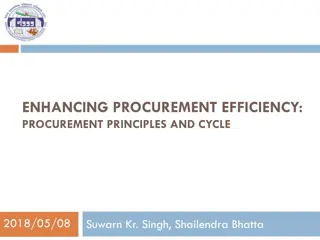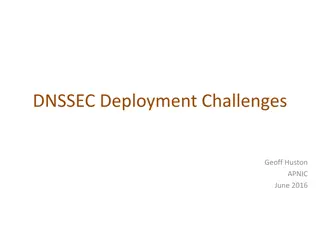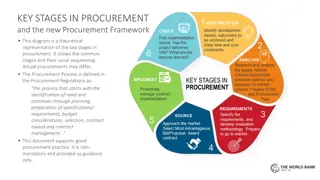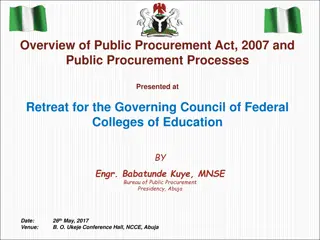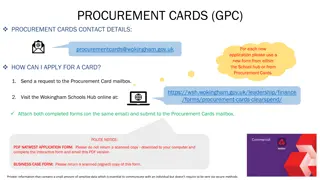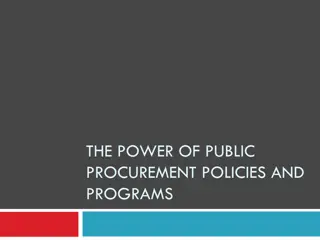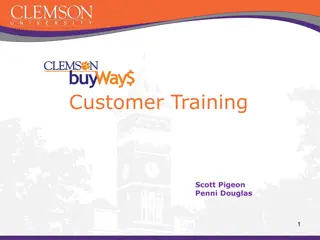Implementing Effective Procurement Strategies at Huston-Tillotson University
This presentation covers the essential aspects of implementing the Uniform Guidance at Huston-Tillotson University, focusing on procurement procedures, administrative requirements, and the challenges faced by early adopters in embracing the new standards. The Uniform Guidance mandates adherence to specific procurement standards to mitigate risks and ensure accountability when using federal funds.
Download Presentation

Please find below an Image/Link to download the presentation.
The content on the website is provided AS IS for your information and personal use only. It may not be sold, licensed, or shared on other websites without obtaining consent from the author.If you encounter any issues during the download, it is possible that the publisher has removed the file from their server.
You are allowed to download the files provided on this website for personal or commercial use, subject to the condition that they are used lawfully. All files are the property of their respective owners.
The content on the website is provided AS IS for your information and personal use only. It may not be sold, licensed, or shared on other websites without obtaining consent from the author.
E N D
Presentation Transcript
Effective Procurement: How to Implement the Uniform Guidance Huston-Tillotson University- The Office of Sponsored Programs and Title III
Agenda 2 Introduction Overview and Background Best Practices for Establishing New Procurement Procedures and Select Administrative Requirements Questions? EFFECTIVE PROCUREMENT STRATEGIES
3 Overview and Agenda Background EFFECTIVE PROCUREMENT STRATEGIES
Procurement Overview 4 The Uniform Guidance (UG) provided a three-year grace period, which expires three full fiscal years following December 26, 2014. This means institutions with a June 30 fiscal year-end must have the new standards in place by July 1, 2018. OMB indicated this will be the final extension to the procurement standards. Grantees shall adhere to the Procurement Standards as specified in 2 CFR 200.317-326, which prescribes consistent standards for use by recipients establishing procedures for the procurement of supplies and services with Federal funds. OMB eliminated the less formal requirements previously set forth in A-110 and has applied the more stringent standards set forth in A-102 to mitigate risks of fraud, waste, and abuse. EFFECTIVE PROCUREMENT STRATEGIES
Procurement Overview 5 Major Changes: Generally, expanded from A-110 The use of must has been include in the overall guidance ( must means required ) Requires quotes and/or price analysis for procurements in excess of $3,500 Requires open competition for procurements in excess of $150,000 New provisions covering conflict of interest with parent, affiliate, or subsidiary organizations Procurements records must be maintained to sufficiently detail the history of the procurement Adequate Competition (The words to the maximum extent practical are removed) - Significantly limits the permissible justifications for sole source procurements EFFECTIVE PROCUREMENT STRATEGIES
Procurement Overview 6 Early Adopters: Some organizations chose to proactively implement the procurement changes ahead of the mandated timing. The new procurement standards represent a major shift in the way institutions approach procurement, and are tough to implement for even the most diligent of institutions. Many early adopters are still struggling with these changes, finding themselves unprepared to handle the stringent new compliance requirements, policy overhauls, training needed at all levels and most importantly the cultural shift the standards introduce. Simultaneously, early adopters have found themselves under increased audit scrutiny from external and governmental auditors. EFFECTIVE PROCUREMENT STRATEGIES
Lessons Learned 7 Most Significant Findings: The cultural shift resulting from new procurement standards should not be underestimated. Most institutions choose vendors and contractors based on past performance and existing relationships, and have done so for many years. These factors will no longer be a permissible basis of selection for direct federally funded procurements, so institutions need to be ready to make major changes in their procedures. The need for documentation has expanded significantly. institutions must now keep all of the quotes received, rationale for selection, cost/price analysis and negotiation memorandum. Purchase orders and contract templates must be updated to include new required flow-down clauses. EFFECTIVE PROCUREMENT STRATEGIES
8 Agenda best Practices in Establishing a Procurement System and Select Administrative Requirements EFFECTIVE PROCUREMENT STRATEGIES
Procurement Standards - Methods of Procurement General Procurement Standards ( 200.318) Must have documented procurement procedures that conform to applicable Federal law (including general procurement standards), State and local laws and regulations Methods of Procurement ( 200.320) Methods of Procurement to be followed 1. Procurement by Micro Purchase (<$3,500*) - may be awarded without soliciting competitive quotations if Non Federal entity considers price to be reasonable. 2. Procurement by Small Purchase Procedures (<$150,000) - price or rate quotations must be obtained from adequate number of qualified sources. 3. Procurement by Sealed Bids (formal advertising) 4. Procurement by Competitive Proposal 5. Procurement by Noncompetitive Proposal Contracting with small and minority-owned businesses. EFFECTIVE PROCUREMENT STRATEGIES
Procurement Standards Permissible Justifications of Sole Source 10 Procurement by Noncompetitive Proposal ( 200.320) Procurement through the solicitation of a proposal from only one source; and May be used when one or more of the following apply: 1. The item is available from a sole source only; 2. Public emergency will not allow a delay resulting from competitive solicitation; 3. Noncompetitive proposals are authorized in response to a written request from the non-Federal entity; and 4. The competition is considered inadequate after a soliciting a number of sources. EFFECTIVE PROCUREMENT STRATEGIES
Procurement Standards Consultants 11 Not explicitly discussed in the Uniform Guidance The cost principles classify consultants as professional services. Since a contract is the legal means to purchase services needed to carry out the project or program under a Federal award, and as a consultant is providing a professional service to carry out the project or program, guidance is that this falls under the contractor definition. Additionally, under 2 CFR 200.319 Competition, it states: (a) Some of the situations considered to be restrictive of competition include but are not limited to: (4) Noncompetitive contracts to consultants that are on retainer contracts; (d) The non-Federal entity must ensure that all prequalified lists of persons, firms, or products which are used in acquiring goods and services are current and include enough qualified sources to ensure maximum open and free competition. EFFECTIVE PROCUREMENT STRATEGIES
Procurement Standards Source Selection . Establish an evaluation team Approve source selection strategy or acquisition plan in advance of RFP release Ensure consistency Solicitation requirements, notices, instructions, evaluation factors, solicitation provisions, contract clauses, and data requirements Ensure proposals are evaluated based solely on factors contained in the solicitation Select the source whose proposal is the best value to the Government Lowest price is not always best! - Lowest price technically acceptable selection Trade-off evaluation process Lowest price technically acceptable selection Evaluate: Cost or price Past performance Technical proposal EFFECTIVE PROCUREMENT STRATEGIES
Procurement Standards Source Selection (continued) 13 Cost/price analysis to determine reasonableness Justifies the source selection as a responsible subcontractor/vendor Price Analysis - Process of examining and evaluating a proposed price without evaluating its separate cost elements and proposed profit. Determines whether the price is fair and reasonable. Cost Analysis - Evaluates the separate cost elements, profit, and facilities capital cost of money. Used to evaluate/determine any or all of the following: 1. cost and/or price reasonableness 2. cost realism 3. most probable cost 4. all costs must be allowable per the cost principles 5. profit must be negotiated separately. It is the more costly method in terms of time and manpower. EFFECTIVE PROCUREMENT STRATEGIES
Procurement Standards Conflict of Interest 14 What is a conflict of interest? Unable or appears to be unable to be impartial or make objective decision Financial interest May have standard if insubstantial Personal relationship Not arms length if related entity Any tangible benefit from firm Potential employment opportunity Tangible benefit to employee or family member No Solicitation or Acceptance of gifts from contractors or subcontractors May establish nominal amount - $25 EFFECTIVE PROCUREMENT STRATEGIES
Procurement Standards Effective Procurement Files 15 Documentation to Maintain should tell the entire story Request for Quotation (Market Research Full and Open Competition) Commercial Item Determination Cost/Price Analysis Negotiation Memorandum Suspension/Debarment check and certification from subrecipient Conflict of Interest evaluation Signature authority & reviews for procurements Maintaining up to date list of flow-downs to protect institutions audit rights EFFECTIVE PROCUREMENT STRATEGIES
Procurement Standards Summary 16 What does a compliant procurement system look like? Maintain adequate descriptions of the system including policies, procedures, and purchasing practices that comply with applicable laws, regulations, and contract terms and conditions; Mitigate against conflicts of interest; Ensure applicable flow down clauses and terms and conditions are included in contracts, as required to execute the requirements of the award; Clearly define lines of authority and responsibility within the system; Ensure procurements are based on authorized requisitions; Define contractor evaluation criteria and methods for determining source selection; EFFECTIVE PROCUREMENT STRATEGIES
Procurement Standards Summary (continued) 17 What does a compliant procurement system look like? Perform timely cost/price analysis and technical evaluations to determine cost/price is fair and reasonable; Maintain documentation which details the complete and accurate history of the purchase transaction to support method, contractor selected/basis of award, and reasonableness of cost/price; Implement strong contractor monitoring and management of controls; Ensures effective and efficient procurement of required quality supplies and services at reasonable cost/price from responsible and reliable sources. Address adequate competition. EFFECTIVE PROCUREMENT STRATEGIES
Best Practices Establishing New Procurement Procedures 18 Conduct a gap assessment by reviewing current policies and procedures and comparing them to the new requirements under Uniform Guidance. Based on the flags raised during the assessment, revise your procurement Be sure to include written standards of conduct covering conflicts of interest in your procurement policy. Think about your culture: How do you buy goods and services? Who are the buyers within your organization? How will this new policy affect them? What practices can be used to be sure that your programs and mission are not negatively impacted? Understand when cost and/or price analysis is necessary, and how it can be documented. For example, how does your organization document sole source cost analysis during an emergency procurement? Ensure everyone involved in the procurement process understands the new requirements and policy. Provide multiple rounds of training at every level of your organization. EFFECTIVE PROCUREMENT STRATEGIES
Best Practices After Establishing New Procurement System 19 Once your policy changes have been effective for a reasonable amount of time, use your internal audit function to ensure your new procedures and controls are operating effectively. Embed the design the federal grant procurement processes into the overall institutional procurement process. Consider leveraging technology to automate the purchasing process, improving controls and compliance and creating processes efficiencies Note: Many institutions have limited resources to identify compliance issues and craft policy updates and solutions. Seeking outside help often proves to be an efficient way to be honest about your compliance, identify any flaws and get compliant quickly. EFFECTIVE PROCUREMENT STRATEGIES
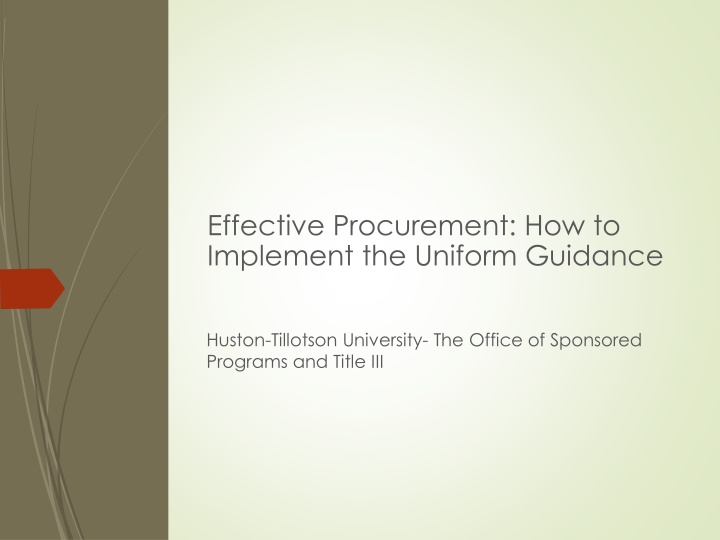



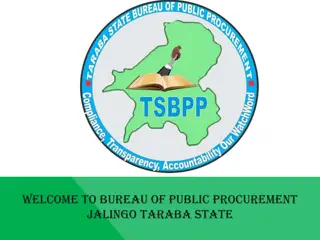
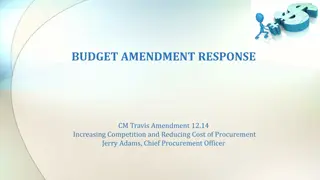
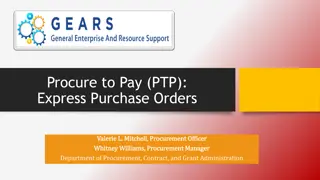
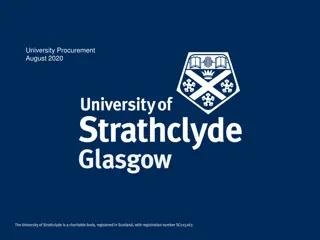
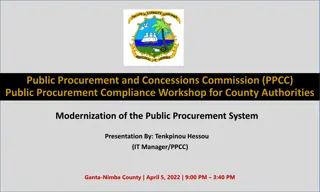
![Comprehensive Overview of Corruption Watch Submission on Public Procurement Bill [B18B-2023]](/thumb/138344/comprehensive-overview-of-corruption-watch-submission-on-public-procurement-bill-b18b-2023.jpg)
